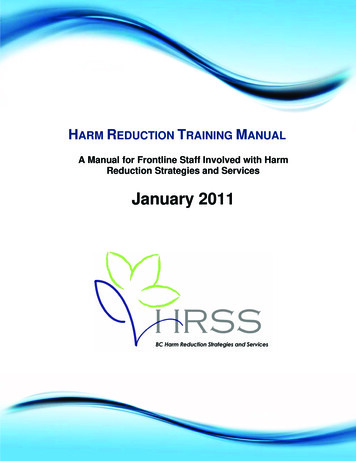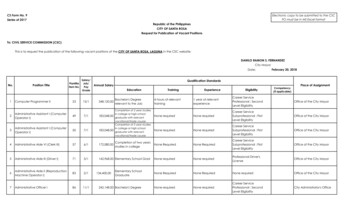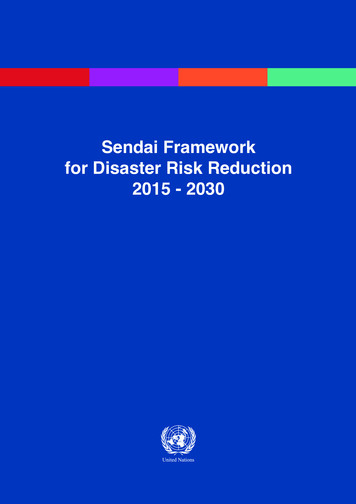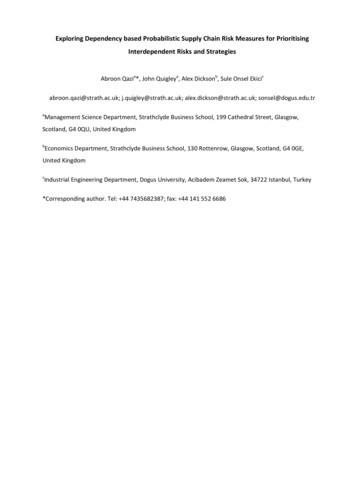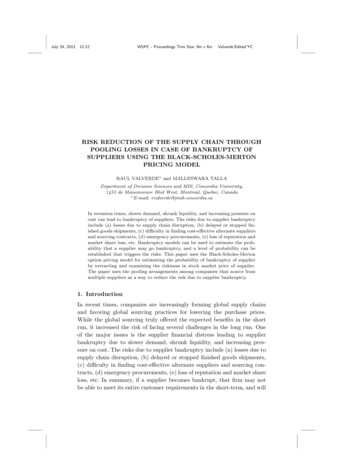
Transcription
July 24, 201212:12WSPC - Proceedings Trim Size: 9in x 6inValverde Edited YCRISK REDUCTION OF THE SUPPLY CHAIN THROUGHPOOLING LOSSES IN CASE OF BANKRUPTCY OFSUPPLIERS USING THE BLACK-SCHOLES-MERTONPRICING MODELRAUL VALVERDE and MALLESWARA TALLADepartment of Decision Sciences and MIS, Concordia University,1455 de Maisonneuve Blvd West, Montreal, Quebec, Canada E-mail: rvalverde@jmsb.concordia.caIn recession times, slower demand, shrunk liquidity, and increasing pressure oncost can lead to bankruptcy of suppliers. The risks due to supplier bankruptcyinclude (a) losses due to supply chain disruption, (b) delayed or stopped finished goods shipments, (c) difficulty in finding cost-effective alternate suppliersand sourcing contracts, (d) emergency procurements, (e) loss of reputation andmarket share loss, etc. Bankruptcy models can be used to estimate the probability that a supplier may go bankruptcy, and a level of probability can beestablished that triggers the risks. This paper uses the Black-Scholes-Mertonoption pricing model for estimating the probability of bankruptcy of supplierby extracting and examining the riskiness in stock market price of supplier.The paper uses the pooling arrangements among companies that source frommultiple suppliers as a way to reduce the risk due to supplier bankruptcy.1. IntroductionIn recent times, companies are increasingly forming global supply chainsand favoring global sourcing practices for lowering the purchase prices.While the global sourcing truly offered the expected benefits in the shortrun, it increased the risk of facing several challenges in the long run. Oneof the major issues is the supplier financial distress leading to supplierbankruptcy due to slower demand, shrunk liquidity, and increasing pressure on cost. The risks due to supplier bankruptcy include (a) losses due tosupply chain disruption, (b) delayed or stopped finished goods shipments,(c) difficulty in finding cost-effective alternate suppliers and sourcing contracts, (d) emergency procurements, (e) loss of reputation and market shareloss, etc. In summary, if a supplier becomes bankrupt, that firm may notbe able to meet its entire customer requirements in the short-term, and will
July 24, 201212:12WSPC - Proceedings Trim Size: 9in x 6inValverde Edited YCnot meet any customer requirements if it eventually goes out of business(see Zsidisin and Wagner7 ). A firm is obliged to evaluate the financial viability of suppliers in order to avoid the consequences of supplier default,insolvency, or bankruptcy (see Milne3 and Wagner and Johnson6 ).The good tools for financial evaluation are the bankruptcy models, asthese can be used for estimating the probability that a supplier may gobankrupt, and a level of probability can be established that triggers therisks. This paper uses the Black-Scholes-Merton option pricing model1 forestimating the probability of bankruptcy of supplier by extracting and examining the riskiness in stock market price of supplier. The model assumes:maturity of liabilities equals one year; the dividend rate is based on the sumof common dividends, preferred dividends, and interest expense; call optionequation has been modified to account for the fact that shareholders receivecommon dividends.1In order to minimize the risk of bankruptcy among suppliers, the paperproposes the use of a pooling arrangement among companies. In a poolingarrangement, every participant agrees to share losses equally, each payingan average loss. The arrangement does not change the expected loss butreduces uncertainty because the variance decreases. This makes the lossesdue to supplier bankruptcy become more predictable since the maximumprobable loss declines and the distribution of costs becomes more symmetric. The predictability increases with the number of participants anddecreases with correlation in losses. Previously, pooling arrangements havebeen used in supply chains for inventory management for the reduction ofdemand variability that can lead to a reduction of safety stock and averageinventory,4 however, this paper combines the use of bankruptcy predictionmodels and pool arrangements for risk reduction in the supply chain. Thispool arrangement methodology could be used as a tool for the preparationof insurance policies that can be sold to companies in order to protect themagainst supplier bankruptcy.2. Black-Scholes-Merton Option Pricing ModelThe bankruptcy losses for suppliers are based on the Black-Scholes-Mertonoption pricing model1. With this model, a company is defined as being inbankruptcy if its corporate value shown by aggregate market value fallsshort of its amount of debt.1 The model captures the likelihood that thevalues of firms assets will decline to such an extent that the firm will beunable to repay its debts.1Equity can be viewed as a call option on the value of the firm’s assets.
July 24, 201212:12WSPC - Proceedings Trim Size: 9in x 6inValverde Edited YCThe strike price of the call option is equal to the face value of the firm’sliabilities and the option expires at time T when the debt matures1.The equation for valuing equity as a call option on the value of the firm’sassets is given in Eq. (1) below. This equation is modified for dividends andreflects that the stream of dividends paid by the firm accrue to the equityholders.The BSM equation is given by (see Wagner and Johnson6 ):VE VA e δT N (d1 ) Xe rT N (d2 ) (1 e δT )VA(1)where N (.) represents the cumulative distribution function of standard normal random variable and d1 and d2 are given by: σ2ln VXA r δ 22 T (2)d1 σA T σ2ln VXA r δ 22 T d2 d1 σA T (3)σA Twhere VE VE (t) is the current market value of equity, VA VA (t) isthe current (at time t) market value of assets, X is the face value of debtmaturing at time T, r is the continuously-compounded risk-free rate, δ isthe continuous dividend rate σA is the standard deviation of asset returns.Under the BSM model, the probability of bankruptcy is simply theprobability that the market value of assets, VA is less than the face value ofthe liabilities, X, at time T. The BSM model assumes that the natural log offuture asset values is normally distributed. The probability of bankruptcyis a function of the distance between the current value of the firm’s assetsand the face value of its liabilities, adjusted for the expected growth in assetvalues relative to asset volatility.As shown in McDonald,2 the probability of bankruptcy can be calculated as: σ2ln VXA µ δ 22 T (4)N σA Twhere µ is the continuously-compounded expected return on assets. Hillegeist et al.5 provided the SAS code for the estimation of VA and σA bysimultaneously solving the BSM equation (1) and the optimal hedge equation given by
July 24, 201212:12WSPC - Proceedings Trim Size: 9in x 6inσE Valverde Edited YCVA e δt N (d1 )σAVE(5)through iterative process. These values are then used to estimate µ fromthe following formula µ maxVA (t) VA (t 1) dividents,rVA (t 1) (6)where dividends in the above equation represent the sum of the commonand preferred dividends declared during the year. This in turn can finallybe used to calculate the probability of bankruptcy.The basic idea for estimating the probability of a supplier companybankruptcy is to recognize the stock price movement pattern of the suppliercompany, and evaluate the historic events information, which is availableto public via company press meets, market focus, etc. The procedure forextracting such information was developed by Hillegeist et al.5 This paperdescribes the reasoning behind using stock prices, as opposed to accountingdata, to extract the probability of supplier bankruptcy estimates as well asthe methodological steps and assumptions behind the estimates.According to option-pricing theories (see McDonald2 ), a market-basedmeasure, that is called Black-Sholes-Model probability of bankruptcy(BSM-PB), should use all available information about the probability ofbankruptcy.5 The BSM-PB contains relatively more information than justthe Score variables used traditionally for bankruptcy prediction, howeverthe accounting measures will not be incrementally informative to BSM-PB.Hillegeist et al.5 tested the validity of these implications using a large sample consisting of 65,960 firm-year observations including 516 bankruptciesduring the 1979-1997 period. They found that BSM-PB has relatively moreexplanatory power than either of the two Scores, even when the Scores aredecomposed to reflect industry differences or annual changes.The model assumes that volatility is a crucial variable in bankruptcyprediction since it captures the likelihood that the values of firms assets willdecline to such an extent that the firm will be unable to repay its debts.Equity can be viewed as a call option on the value of the firm’s assets.The strike price of the call option is equal to the face value of the firm’sliabilities and the option expires at time T when the debt matures.
July 24, 201212:12WSPC - Proceedings Trim Size: 9in x 6inValverde Edited YC3. Risk Reduction through Pooling Independent LossesA risk pool is one of the forms of risk management practiced in insurance.Pooling arrangements do not change a company’s expected loss, but reducethe uncertainty (standard deviation) of a loss. Risk pooling arrangementsmake each participant’s loss more predictable ( Zsidisin and Wagner7 ).Correlation analysis is very important in pooling arrangements. A positive correlation in losses is less desirable than null correlation (uncorrelatedlosses) in the context of risk management. While a positive correlation inlosses reduces the extent to which risk pooling lowers the standard deviation of losses, null correlation in losses increase it. The concept of poolinglosses has been used in supply chain (see Milne3 ). Risk pooling suggests thatdemand variability is reduced if one aggregates demand across locations because as demand is aggregated across different locations, it becomes morelikely that high demand from one customer will be offset by low demandfrom another. This reduction in variability allows a decrease in safety stockand therefore reduces average inventory, this suggests that the use centralized warehouses would be able to reduce inventory costs as it reduces safetystock but this benefit will decrease as the correlation between demands demanding inventory becomes positive (see Milne3 ).The expected loss and variance for a company C associated with Msuppliers, due to supplier bankruptcy can be estimated byMXLi Pi ,(7)(Li L̄C )2 Pi ,(8)L̄C i 1and2σC MXi 1respectively, where Li is the loss of a company due to supplier bankruptcy,Pi is the probability of bankruptcy of a supplier.In the context of the proposed research, each firm in the pool is willingto share the losses generated due to bankruptcy of suppliers. The researchwill show how the mechanism can be used to reduce the standard deviationof the losses associated with risk of losses.4. Illustration of the Methods on Real DataIn order to find the probability of bankruptcy, a research was conductedby selecting 23 companies that trade in the stock market and publish their
July 24, 201212:12WSPC - Proceedings Trim Size: 9in x 6inValverde Edited YCfinancial statements. The BSM model has been used for calculating theprobability of bankruptcy for these 23 firms for the first quarter for theyear 2000. A scenario of two companies that have three suppliers each wasgenerated and the losses due to bankruptcy for each supplier were pooledamong the two companies and the expected loss and standard deviation oflosses calculated by pooling losses. The objective of the research is to showthat the risk pooling contract minimizes the risk exposure.A SAS program generated by Hillegeist et al.5 was used to calculate theprobability of bankruptcy. The calculation was performed in three steps. Inthe first step, the values of VA and σA were estimated by simultaneouslysolving the call option B-S-M equation (Eq. (1)) and the optimal hedgingequation (Eq. (4)).In the initial step, VE was set equal to the total market value of equity based on the closing price at the end of the firm’s fiscal year, σE wascomputed using daily return data from the Center for Research in Security Prices database (http://www.crsp.com) over the entire fiscal year. Thestrike price X was set equal to the book value of total liabilities, T wastaken to be one year, and r was set at the one-year treasury bill rate. Thedividend rate, δ, was the sum of the prior year’s common and preferred dividends divided by the approximate market value of assets, which is definedas total liabilities plus the market value of equity.In the second step, the expected market return on assets, µ, was calculated based on the actual return on assets during the previous year andwith the help of Eq. (6). This process is based on the estimates of VA thatwere computed in the previous step.Finally, the values for VA , σA , δ, T, X and µ were used to calculate theprobability of bankruptcy for each firm-year via Eq. (4). To do this, thevalue inside the parentheses in Eq. (4) was first calculated to then determine the probability of bankruptcy corresponding to this value using thestandard normal distribution.Table 1 presents the probability of bankruptcy for the 23 companiesbased on the first quarter of the year 2000. The same table displays thevalues of VA and σA calculated in the first step.The scenario used for this analysis assumes two companies with threesuppliers each. The loss due to bankruptcy for each supplier is assumedto be constant and estimated to be 5000, which include losses due tosupply chain disruption, delayed or stopped finished goods shipments, difficulty in finding cost-effective alternate suppliers and sourcing contracts,emergency procurements, loss of reputation and market share among the
July 24, 201212:12Table 1.WSPC - Proceedings Trim Size: 9in x 6inValverde Edited YCProbabilities of bankruptcy for suppliers for Year 2000 and Quarter 1.Supplier companyAAR CORPADC TELECOMMUNICATIONS INCALPHARMA INCUNITED DOMONION INDUSTRIESAMC ENTERTAINMENT INCAMR CORP/DECECO ENVIRONMENTAL CORPASA BERMUDA LTDAVX CORPPINNACLE WEST CAPITALAARON RENTS INCABITIBI CONSOLIDATED INCABRAMS INDUSTRIES INCACKERLY GROUP INCACMAT CORPACME UNITED CORPACTION PRODUCTS INTL INCACTIVISION INCRELM WIRELESS CORPADAMS RESOURCES & ENERGY INCAERO SYSTEMS ENGINEERING INCADVANCES MICRO DEVICESASM INTERNATIONAL Table 2. Company A’s expected losses and standard deviation due to bankruptcy ofsuppliers.SuppliersAAR CORPABRAMS INDUSTRIES INCACTION PRODUCTS INTL INCProbabilityofof d LossStandard deviationLoss due tobankruptcy500050005000Supplier’sexpected loss108.51244.411009.641362.551898.84possible losses. Tables 2 and 3 present the expected losses and standarddeviation of companies A and B due to bankruptcy of their three suppliers,respectively.Table 4 shows the expected losses for the pooling arrangement of thetwo companies. In this arrangement, losses are shared equally between companies A and B. The estimates show that uncertainty represented by thestandard deviation is reduced while the average loss remained unchanged
July 24, 201212:12WSPC - Proceedings Trim Size: 9in x 6inValverde Edited YCTable 3. Company B’s expected losses and standard deviation due tobankruptcy of suppliers.SuppliersASA BERMUDA LTDACKERLY GROUP INCRELM WIRELESS CORPProbabilityofof bankruptcy00.000724470.29516477Loss due tobankruptcy500050005000Supplier’sexpected loss03.621475.82Expected LossStandard deviation1479.451915.03((1362.55 1479.45)/2 1421).Table 00200002500015000200002500030000Pooling arrangement between companies A and B.Portion 50010000125007500100001250015000Probabilityof 6.32896E-054.58051E-080Expected LossStandard deviationExpected 0.0005701421.001601.44
July 24, 201212:12WSPC - Proceedings Trim Size: 9in x 6inValverde Edited YC5. Conclusions and Future ResearchThis study clearly demonstrates the usefulness of estimating the probability of bankruptcy of suppliers for managing the risk to a supply chain.The results presented show how the pooling contracts can help companiesto minimize the risk of losses due to supplier bankruptcy. These poolingcontracts can be managed by insurance carriers and sold to companiesas supplier bankruptcy insurance. Furthermore, the pooling contracts helpcompanies minimize the risk. Here we used a simple scenario with a poolingarrangement with two companies and three suppliers. Although this paperassumes that a company does not experience any loss while a supplier is notbankrupt, unexpected events (fluctuations in price, etc.) may amount to acertain loss. The analysis and computation of this paper can be revised toaccount for such factors. Moreover, the future research can include differenttypes of risks and estimates for other types of supply chain risks, and conduct a study with multiple scenarios in order to provide more evidence thatthe concept can work in industry. Future work can also include a softwareprogram which can be developed for any number of supplier companies andpooling contracts with increased participation.References1. F. Black and M. Scholes, The Journal of Political Economy 81, 637 (1973).2. R. McDonald, Derivative Markets (Addison Wesley, Boston, MA, 2002).3. Richard Milne, Early Warnings in the Supply Chain, In Financial Times Europe, No. 36957, pp. 10 (2010).4. D. Simchi-Levi, P. Kaminsky and E. Simchi-Levi, Designing & Managing theSupply Chain, second edition (McGraw Hill, New York, USA, 2003).5. Stephen A. Hillegeist, Elizabeth K. Keating, Donald P. Cram, Kyle G. Lundstedt, Review of Accounting Studies 9, 5 (2004).6. S. M. Wagner and J. L. Johnson, Industrial Marketing Management 33, 717(2004).7. G. A. Zsidisin and S. M. Wagner, Journal of Business Logistics 31, 1 (2010).
A risk pool is one of the forms of risk management practiced in insurance. Pooling arrangements do not change a company's expected loss, but reduce the uncertainty (standard deviation) of a loss. Risk pooling arrangements make each participant's loss more predictable ( Zsidisin and Wagner7). Correlation analysis is very important in pooling .






